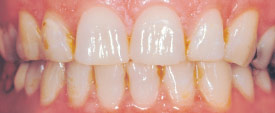Planning Successful Dental Treatment

Meet Delene
 |
| Delene's teeth were getting shorter, accentuating her gummy smile; a gap was evident between her two front teeth. |
Delene was just 30 years old, yet she was becoming increasingly uncomfortable with her smile. She had always shown a lot of gum when smiling, she had a space between her two front teeth, and now her teeth seemed to be getting shorter.
“I just felt like I had short, square teeth and I didn't like 'em,” she recalled recently. “I was just ready to make a change.”
Although Delene had always gone to the dentist regularly and taken good care of her teeth, she had a number of fillings that she felt were unattractive.
“The frustrating part for me growing up was that I felt I had really good oral hygiene,” Delene said. “I have a brother who didn't, and I think he's only had one cavity in his whole life. We just have very different teeth.”
When I asked how she felt about her smile, she said she wasn't happy with it. While her teeth were straight and she had never needed braces, she did not like how gummy her smile looked. She also wanted her teeth to be whiter and larger. She told me she wanted a smile as beautiful as Julia Roberts'. “I just love her smile — everything about it,” she said.
Assessing Delene's Risk
Armed with this information, I could now go to work. Here's how I used each parameter we discussed in the opening section to assess Delene's risk:
Periodontal Risk: Low
 |
| Periodontal Risk — Low — no inflammation, recession, or bone loss — all of which would be signs of gum disease. |
On examination, Delene had none of the typical signs of periodontal (gum) disease — no bone loss, tooth looseness, or gum recession. She was a non-smoker (smoking is a major risk factor for periodontal disease) and her general health was good. Oral hygiene habits were fairly good. All that was needed to further reduce periodontal risk was some training to improve her brushing and flossing technique and sticking to a schedule of professional cleanings and checkups every six months.
Biomechanical Risk: High
 |
| Biomechanical Risk — High — many new cavities and old, weak and structurally unsound fillings in need of replacement. |
My examination also revealed that Delene had three active (progressive) cavities. She also had tooth erosion, which is due to acid attacking the tooth surfaces. Many teeth were also structurally compromised — meaning that some of her natural tooth material had been lost because of prior decay. Many of her fillings were breaking down. In sum, Delene had far too many fillings and a decay rate that was too high.
Functional Risk: Moderate
 |
| Functional Risk — Moderate — determined by the degree of tooth wear and its affect of unbalancing her bite. |
Delene's front teeth were getting shorter, largely as a result of wear. As her many fillings were wearing (in her back teeth), her bite was no longer hitting in harmony. Many of her teeth were not hitting at the same time causing her to squeeze harder to make her teeth fit together. Luckily, the wear was moderate and her bite could easily be restored, indicating that her risk in this category was moderate.
Aesthetic Risk: High
 |
| Aesthetic Risk — High — whenever a lot of gum tissue shows in the smile and all of the front teeth are visible, the aesthetic risk is high. |
The way teeth are positioned within the face, and how the smile relates to the face proportionally are matters of aesthetics. These judgments by nature tend to be subjective. That's why what Delene felt about her smile was critically important. The problem of “gummy smiles” can be very difficult to deal with. There is more than one thing that can cause a gummy smile and more than one treatment option to correct it. Delene's smile showed excessive gum, making her aesthetic risk high.



